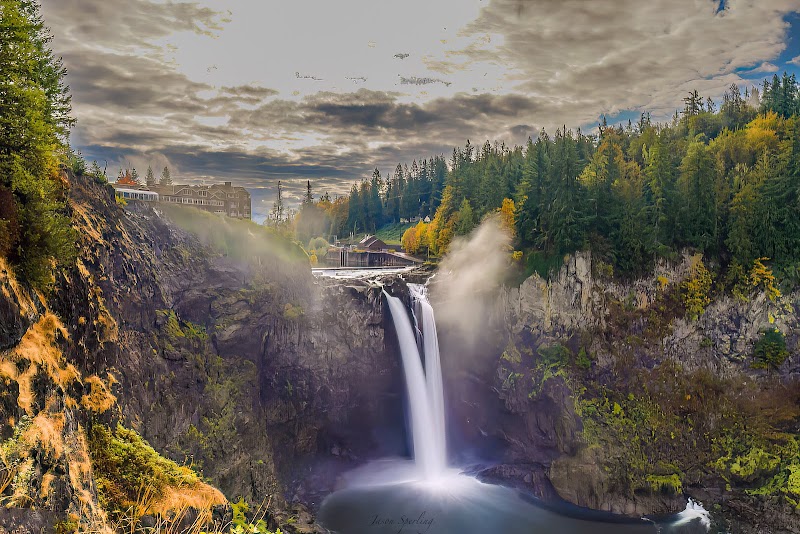
Navigating Transportation Options Near Snoqualmie, Washington
Explore practical transportation solutions around Snoqualmie, Washington, to make your outdoor adventures seamless. From highway access to public transit and rideshares, discover how to move effortlessly while planning your visit to this outdoor hub.
Arrive Early for Parking
Popular parking areas near Snoqualmie Falls fill quickly, especially on weekends—plan to arrive early to secure a spot and avoid long waits.
Check Public Transit Schedules
King County Metro buses serve Snoqualmie, but schedules can fluctuate; always check times ahead of your trip to avoid waiting.
Prepare for Seasonal Road Conditions
Winter snow and ice can impact road safety around Snoqualmie; ensure your vehicle is equipped with appropriate tires and emergency gear.
Carpool or Use Shuttle Services
Reduce parking stress and environmental impact by sharing rides to trailheads or using local shuttle options where available.
Navigating Transportation Options Near Snoqualmie, Washington
Navigating Transportation Options Near Snoqualmie, Washington
Snoqualmie’s rugged terrain and enchanting natural landmarks demand a reliable and flexible transportation setup. Whether you’re arriving for an adventurous hike up Snoqualmie Falls or exploring the quiet trails around Tiger Mountain, knowing your transportation options in and around Snoqualmie, Washington, is critical for a smooth experience.
Getting to and Around Snoqualmie
Snoqualmie is connected by Interstate 90, offering easy highway access from Seattle and other regional hubs. For visitors without a personal vehicle, King County Metro buses provide scheduled routes servicing Snoqualmie and surrounding towns, with stops near major trailheads and parks. Rideshare services like Uber and Lyft operate regularly here, providing convenient point-to-point transit.
Parking and Vehicle Considerations
Ample parking is available at major attractions such as Snoqualmie Falls Park and Snoqualmie Point Park, but during peak seasons, arriving early is crucial to secure a spot. For mountain bikers and hikers, trailhead parking areas may have limited spaces; carpooling or shuttle services can reduce wait times and environmental impact.
Keyword Focus for SEO
Transportation in Snoqualmie, Washington, covers multiple modalities: car access via I-90, public transit routes from King County Metro, and popular rideshare options. Travelers often search for "parking near Snoqualmie Falls," "public transportation to Snoqualmie trails," and "best shuttle services in Snoqualmie." Keywords like "Snoqualmie trailhead parking," "bus routes Snoqualmie," and "transportation near Snoqualmie hiking" capture relevant user intent.
Practical Travel Tips
Planning your transportation means considering distance, timing, and terrain. The roads curve through steep hillsides—drivers should be alert for shifting weather patterns and occasional winter snow. Public transit schedules may vary on weekends and holidays, so check in advance. Rideshare surge pricing peaks during busy weekends when outdoor activities are in full swing.
Below are some nearby adventures to enhance your trip in Snoqualmie and discover its sprawling outdoor playground.
Nearby Trips
All Adventures
Boat Charters
Water Activities
Adventures near Issaquah, Washington
Discover the unique and memorable adventures that make Issaquah, Washington special.
Frequently Asked Questions
What is the best way to get to Snoqualmie without a car?
King County Metro buses run routes connecting Snoqualmie with the greater Seattle area, but schedules are less frequent during weekends. Pairing bus use with rideshares can cover last-mile transit efficiently.
Are there shuttle services available for popular trailheads?
Shuttle options are limited but sometimes seasonal and event-based. Check local outdoor recreation groups or park websites for updates and availability near major trailheads.
Is parking free near Snoqualmie Falls and other attractions?
Yes, parking is generally free at major sites such as Snoqualmie Falls Park, but spaces fill quickly during peak periods, so arriving early or carpooling is advised.
Can I bike safely around Snoqualmie to reach trailheads?
Cycling around Snoqualmie involves negotiating rural roads with some steep inclines. Use caution, wear protective gear, and be prepared for limited bike lanes or shoulders.
What should I do if I get caught in sudden weather changes while hiking near Snoqualmie?
Carry weather-appropriate layers, stay on marked trails, and turn back if conditions worsen. Keeping a charged phone and letting someone know your route helps in emergencies.
Are pets allowed on public transportation to Snoqualmie?
King County Metro allows small pets in carriers on buses, but check specific transit policies. Most outdoor trails welcome pets on leash, but watch for wildlife and seasonal restrictions.
Recommended Gear
Sturdy Hiking Boots
Provide reliable grip and ankle support on rocky or wet terrain throughout all seasons.
Water Bottle or Hydration Pack
Stay hydrated, especially in warmer months when physical exertion and sun exposure increase fluid needs.
Weather-Appropriate Layering
Use moisture-wicking and insulating layers to adjust to variable weather common around Snoqualmie.
Traction Devices (Crampons or Microspikes)
Necessary for icy trails and snowy conditions to maintain footing on slick surfaces.
Local Insights
Hidden Gems
- "Far fewer visitors explore the Rattlesnake Ledge trail early morning, offering stunning views without crowds."
- "Mint Creek Falls trail features a serene waterfall less trafficked than Snoqualmie Falls."
Wildlife
- "Black-tailed deer roam the forests surrounding Snoqualmie, often curiously crossing trails."
- "Listen for the call of pileated woodpeckers tapping through tall old-growth trees."
History
"Snoqualmie’s history is intertwined with the local Snoqualmie Tribe, whose heritage trails and cultural sites can be explored respectfully with local guides."